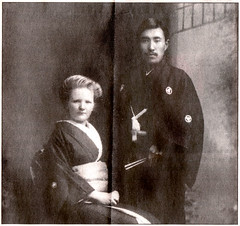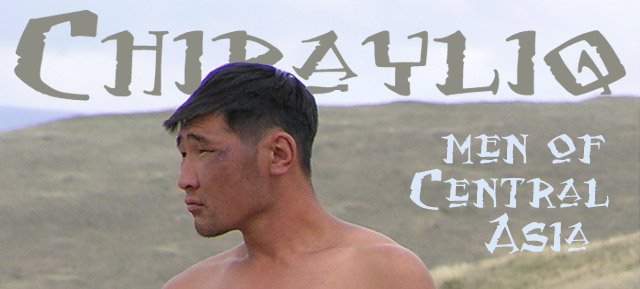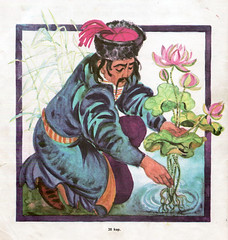Monday, 28 July 2008
Georgian Jazz, 1969
Folk/jazz fusion band Orera from the Georgian SSR performs "Krimanchuli" in the TV film "Moscow in notes" (1969). Found in WFMU's Beware of the Blog
Sunday, 27 July 2008
Viktor Tsoi
Viktor Tsoi (Виктор Цой) (1962–1990) was a famous Soviet rock singer and leader of the cult band Kino. Tsoi's father was originally Korean, and his mother was Russian. He died tragically in a car accident. Even today, he is considered "the last hero of rock" among many Russians (the title was bestowed on him in an obituary in Komsomolskaya Pravda).
Kino's lyrics were interpreted as political messages for the youth, against war and for the perestroika movement, although Tsoi occasionally denied any political inclinations. The band received very little financial support from the state and the fans spread the songs as samizdat.
The above clip features Kino's song Группа крови ("Blood Type") from the soundtrack of Kazakh director Rashid Nugmanov's debut film Игла ("Needle", 1988). The film dealt with the controversial topic of drug abuse in a never-before seen way in the Soviet Union; Tsoi plays a young man involved in shady business who returns to Alma-Ata (Almaty) to find his girlfriend addicted, and decides to take on the drug-dealers himself. Nugmanov's career from taboo-breaking filmmaker to political dissident is colourful enough to warrant its own Chirayliq post, so stay tuned.
Monday, 21 July 2008
Khanty Man
 I'm waiting for my own Chirayliq, who will visit me in a couple of days. This is not him, but possibly our distant relative - a Khanty from the Soviet Union, mid 20th century. The Khanty and their neighboring people, the Mansi, speak languages that belong to the Ugric branch of the Finno-Ugric language family. These languages are the closest original relatives of Hungarian.
I'm waiting for my own Chirayliq, who will visit me in a couple of days. This is not him, but possibly our distant relative - a Khanty from the Soviet Union, mid 20th century. The Khanty and their neighboring people, the Mansi, speak languages that belong to the Ugric branch of the Finno-Ugric language family. These languages are the closest original relatives of Hungarian.The Khanty and Mansi were formerly called "Ostyaks" and "Voguls" in Russian. In even older historical records, they are referred to as the inhabitants of Yugra. Yugra became part of the Khanate of Sibir in the 15th century, and thus placed under Tatar rule. Unlike the Russians, the Khanty maintained positive memories of the Tatars. According to Soviet historian S.V. Bakhrushin,
The close connections between the Yugrans and the Turkic Tatars are also demonstrated by the fact that even in the 1660s, the idea of restoring the Kuchum Khanate was still popular with the Khanty of Beryozovo. It was only in the middle of the 17th century that Moscow succeeded in subduing Yugria.This is remarkable, considering that Kuchum Khan was an aggressive Muslim missionary, and the Khanty and Mansi were staunch shamanists well into the 20th century (and many remain today).
There are several nice photos of Khanty life at Flickr.com.
Saturday, 12 July 2008
Finnish-Japanese Couples
A small Northeast-European country with only 5 million inhabitants has small chance to make an impression on an East Asian superpower with 127 millions. Regardless of that, Finnish-Japanese contacts have generally been positive, and as a result, both Finns and Japanese (but especially Finns) sometimes imagine that there is a special relationship between Finnish and Japanese mentality. After all, they are only separated by one country...
Never mind the imagined relationships, here are some very real unions between Finns and Japanese, which I find inspiring and also very cute.
 Siiri Pitkänen and Tadao Watanabe, sometime in the Taisho period (1910's). They met when he came to Finland to study to become a missionary. They lived in Japan and Finland in the 1920's, often far apart, and their longing letters to each other have been published in the book "Kirsikankukkien vuodet" (Cherry Blossom Years). Some of their correspondence reflects family tragedy and marriage arguments, but there are many sweet and longing letters to the "dear quarrel-partner". The article where I found the photo is available online in Finnish.
Siiri Pitkänen and Tadao Watanabe, sometime in the Taisho period (1910's). They met when he came to Finland to study to become a missionary. They lived in Japan and Finland in the 1920's, often far apart, and their longing letters to each other have been published in the book "Kirsikankukkien vuodet" (Cherry Blossom Years). Some of their correspondence reflects family tragedy and marriage arguments, but there are many sweet and longing letters to the "dear quarrel-partner". The article where I found the photo is available online in Finnish.

Here is another handsome couple from the ladies' magazine Hopeapeili (1962/5). The marriage of Miss Pirkko Päiwiö and embassy attaché Minoru Yamashita was a big event in Finland's small society circle. The little article about the "great adventure" describes Mrs Yamashita's future as a challenge. Just the thought of moving to Japan and studying the language makes the reporter's "tongue tie a knot" (pelkästä ajatuksesta kieli solmuun), but "apparently Japanese isn't that difficult". A bigger challenge is the cuisine: Mr Yamashita "has somewhat shown appreciation even of kalakukko and pirogues. A Finnish wife will undoubtedly make sure that also lighter Finnish delicacies will not be missing from the young couple's table, even in Japan." Oh, that old-time food nationalism... I hope they were happy even without the kalakukko.
Never mind the imagined relationships, here are some very real unions between Finns and Japanese, which I find inspiring and also very cute.
 Siiri Pitkänen and Tadao Watanabe, sometime in the Taisho period (1910's). They met when he came to Finland to study to become a missionary. They lived in Japan and Finland in the 1920's, often far apart, and their longing letters to each other have been published in the book "Kirsikankukkien vuodet" (Cherry Blossom Years). Some of their correspondence reflects family tragedy and marriage arguments, but there are many sweet and longing letters to the "dear quarrel-partner". The article where I found the photo is available online in Finnish.
Siiri Pitkänen and Tadao Watanabe, sometime in the Taisho period (1910's). They met when he came to Finland to study to become a missionary. They lived in Japan and Finland in the 1920's, often far apart, and their longing letters to each other have been published in the book "Kirsikankukkien vuodet" (Cherry Blossom Years). Some of their correspondence reflects family tragedy and marriage arguments, but there are many sweet and longing letters to the "dear quarrel-partner". The article where I found the photo is available online in Finnish.
Here is another handsome couple from the ladies' magazine Hopeapeili (1962/5). The marriage of Miss Pirkko Päiwiö and embassy attaché Minoru Yamashita was a big event in Finland's small society circle. The little article about the "great adventure" describes Mrs Yamashita's future as a challenge. Just the thought of moving to Japan and studying the language makes the reporter's "tongue tie a knot" (pelkästä ajatuksesta kieli solmuun), but "apparently Japanese isn't that difficult". A bigger challenge is the cuisine: Mr Yamashita "has somewhat shown appreciation even of kalakukko and pirogues. A Finnish wife will undoubtedly make sure that also lighter Finnish delicacies will not be missing from the young couple's table, even in Japan." Oh, that old-time food nationalism... I hope they were happy even without the kalakukko.
Monday, 7 July 2008
Dombra Love
You just have to see this cute photo of a Kazakh father and baby playing the dombra in Mongolia.
Sunday, 6 July 2008
Kalmoki Muinaisjutte - Kalmyk Fairytales
Illustrated by Estonian artist Siima Škop. Published in the Soviet Union. Tallinn (Estonia), Kirjastus "Eesti raamat" 1981
I found this lovely little book in a used book store in Tartu, Estonia, a couple of years ago. See more illustrations by Škop.
Saturday, 5 July 2008
Johann Trollmann, 1933 German master in light-heavyweight boxing

Johann Trollmann (above left), called "Rukeli" among his friends, grew up in the poorer quarters of Hannover. With his featherlight, acrobatic style of boxing he was ahead of the times - this style would become popular with Sugar Ray Robinson and not least Muhammad Ali much later on in boxing history. Trollmann went on to win the German boxing championships in 1933, when the Nazis were already in power.
His charisma and flamboyant looks, dark locks and "romantic gaze" made him very popular among the ladies. Among some of the gents he was much less popular, and his fighting style was scoffed at as being "unmanly", "a circus attraction", and (by the NSDAP party organ Völkischer Beobachter) "not German".

In the increasingly racist climate in Germany, Trollmann's ethnic background was held against him. He belonged to the Sinti minority (a subgroup of Roma), and "the fact that a sportsman from a despised minority - 1933 there were approximately 15,000 Sinti and Roma living in Germany - would make "Aryan" athletes look like fools in the martial sport boxing, of all things, and thus rebut the supposed superiority of the Nordic race, was terribly annoying to the Nazi ideologists", as der Spiegel writes.
Trollmann fought for the German light-heavyweight title on June 9th, 1933. The German boxing federation was at the time already infested with Nazis, and although he clearly led by points over his opponent, the fight was judged "no result". The audience rebelled, and the Nazi officials were forced to acknowledge Trollmann as the victor. Still, eight days later his title was taken from him due to "pathetic behaviour", perhaps referring to his tears of joy when his title was finally announced.
On July 21st, Trollmann was scheduled for the next fight. He was threatened that he would lose his boxing licence if he would continue "dancing around in the ring". Trollmann entered the fight with his hair bleached blond and his skin powdered white with flour. He stood still and took his opponent Gustav Eder's blows without countering or fighting back for five rounds until he collapsed.

When the war began, German Roma (unlike German Jews) were drafted into the army, and Johann Trollmann was wounded while serving on the eastern front. But in December 1942, Himmler enacted the "Auschwitz decree", which declared Roma to be on the same level as Jews.
Trollmann was arrested and brought to the concentration camp Neuengamme, where he was repeatedly forced to fight with SS officers. He has been thought to have died under unclear circumstances in 1943; the research of Roger Repplinger (author of a double biography of Trollmann and footballer Tull Harder, who became an SS officer and served in Neuengamme) points to him dying in 1944 at a smaller camp in Wittenberge.
 It was only in 1993 that Trollmann got recognition and was posthumously taken into "the ranks of German masters" as German champion in light-heavyweight boxing. In 2003, seventy years after his victory, Trollmann's surviving relatives received his championship belt from the German professional boxing federation. A small street in the old town of Hannover was named after him.
It was only in 1993 that Trollmann got recognition and was posthumously taken into "the ranks of German masters" as German champion in light-heavyweight boxing. In 2003, seventy years after his victory, Trollmann's surviving relatives received his championship belt from the German professional boxing federation. A small street in the old town of Hannover was named after him.Photos from Leg dich, Zigeuner - Die Geschichte von Johann Trollmann und Tull Harder by Roger Repplinger, via der Spiegel.
See also Manuel Trollmann's website about his great-uncle (in German).
Update, July 2010: A temporary memorial has been designed for Johann Trollman by Bewegung NURR. Check the website to see where it is currently being shown.
Subscribe to:
Comments (Atom)





